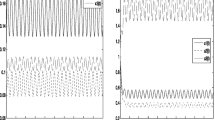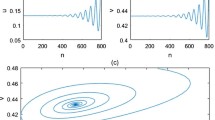Abstract
In this paper, a generalized Lotka-Volterra (GLV) system, which is modeled by a set of equations that represents the dynamical behaviors of two-predator and one prey species, is analysed. The boundedness, existence and uniqueness of the solutions of the generalized Lotka-Volterra system are studied. Continuous dependence on initial conditions in the model is also studied to determine the parameter values’ range of the model and time T where the system does not exhibit chaotic behaviors. In addition, extinction scenarios of solutions of the model are discussed. The necessary and sufficient conditions for the asymptotic stability of the equilibrium points of the GLV system are derived. It is also shown that the GLV system undergoes a saddle-node bifurcation and generalized Hopf (Bautin) bifurcation around one of its equilibrium points. The coexisting periodic solutions and chaotic attractors in the system are numerically investigated by phase diagrams and Lyapunov exponent spectrum. Linear feedback control technique is utilized to control the GLV model to its equilibrium points. Moreover, the Lyapunov direct method is used to synchronize two identical chaotic GLV models via linear feedback control technique.







Similar content being viewed by others
References
Lorenz EN (1963) Deterministic nonperiodic flow. J Atmos Sci 20(2):130–141
Rössler OE (1976) An equation for continuous chaos. Phys Lett A 57:397–398
Fu SH, Lu QS (2014) Set stability of controlled Chua’s circuit under a non-smooth controller with the absolute value. Int J Control Autom Syst 12(3):507–517
Chen G, Ueta T (1999) Yet another chaotic attractor. Int J Bifurc Chaos 09(07):1465–1466
Matouk AE (2008) Dynamical analysis, feedback control and synchronization of Liu dynamical system. Nonlinear Anal Theory Methods Appl 69(10):3213–3224
Matouk AE, Agiza HN (2008) Bifurcations, chaos and synchronization in ADVP circuit with parallel resistor. J Math Anal Appl 341(1):259–269
Zhou W, Pan L, Li Z, Halang WA (2009) Non-linear feedback control of a novel chaotic system. Int J Control Autom Syst 7(6):939–944
Pan L, Zhou W, Fang J (2010) Dynamics analysis of a new simple chaotic attractor. Int J Control Autom Syst 8(2):468–472
Mahmoud GM, Bountis T (2004) The dynamics of systems of complex nonlinear oscillators: a review. Int J Bifurc Chaos 14(11):3821–3846
Mahmoud GM, Aly SA, AL-Kashif MA (2008) Dynamical properties and chaos synchronization of a new chaotic complex nonlinear system, Nonlinear Dyn 51(1):171–181
El-Sayed AMA, Nour HM, Elsaid A, Matouk AE, Elsonbaty A (2014) Circuit realization, bifurcations, chaos and hyperchaos in a new 4D system. Appl Math Comput 239:333–345
Lotka AJ (1925) Elements of physical biology. Williams and Wilkins, Baltimore
Freedman HI, Waltman P (1977) Mathematical analysis of some three-species food-chain models. Math Biosci 33(3–4):257–276
Freedman HI (1980) Deterministic mathematical models in population ecology. Marcle Dekker, New York
Murray JD (1993) Mathematical biology. Springer, New York
Kuznetsov Y, Rinaldi S (1996) Remarks on food chain dynamics. Math Biosci 134(1):1–33
Castillo-Chavez C, Feng Z (1998) Global stability of an age-structure model for TB and its applications to optimal vaccination strategies. Math Biosci 151:135–154
Kot M (2001) Elements of mathematical ecology. Cambridge University Press, Cambridge
Castillo-Chavez C, Song B (2004) Dynamical models of tuberculosis and their applications. Math Biosci Eng 1(2):361–404
Freedman HI, Waltman P (1984) Persistence in a model of three interacting predator-prey populations. Math Biosci 68:213–231
Erbe LH, Freedman HI, Rao VSH (1986) Three-species food-chain models with mutual interference and time delays. Math Biosci 80(1):57–80
Gómez JM, Zamora R (1994) Top-down effects in a tritrophic system: parasitoids enhance plant fitness. Ecology 75(4):1023–1030
Xiao Y, Chen L (2001) Modeling and analysis of a predator-prey model with disease in the prey. Math Biosci 171(1):59–82
Ruan S, Xiao D (2001) Global analysis in a predator-prey system with nonmonotonic functional response. SIAM J Appl Math 61(4):1445–1472
Venturino E (2002) Epidemics in predator-prey models: disease in the predators. Math Med Biol 19(3):185–205
Tewa JJ, Djeumen VY, Bowong S (2013) Predator-Prey model with Holling response function of type II and SIS infectious disease. Appl Math Model 37:4825–4841
Sharma S, Samanta GP (2015) Analysis of a two prey one predator system with disease in the first prey population. Int J Dyn Control 3(3):210–224
Gurubilli KK, Srinivasu PDN, Banerjee M (2016) Global dynamics of a prey-predator model with Allee effect and additional food for the predators. Int J Dyn Control. doi:10.1007/s40435-016-0234-1
Shehata AM, Elaiw AM, Elnahary EK, Abul-Ez M (2016) Stability analysis of humoral immunity HIV infection models with RTI and discrete delays. Int J Dyn Control. doi:10.1007/s40435-016-0235-0
Hastings A, Powell T (1991) Chaos in a three-species food chain. Ecology 72(3):896–903
Holling CS (1965) The functional response of predators to prey density and its role in mimicry and population regulation. Mem Entomol Soc Can 45:3–60
Pielou EC (1977) Mathematical ecology. Wiley, New York
Upadhyay RK, Rai V (1997) Why chaos is rarely observed in natural populations. Chaos Solitons Fract 8(12):1933–1939
Zimmer C (1999) Life after chaos. Science 284(5411):83–86
Cushing JM, Henson SM, Desharnais RA, Dennis B, Costantino RF, King A (2001) A chaotic attractor in ecology: theory and experimental data. Chaos Solitons Fract 12:219–234
Samardzija N, Greller LD (1988) Explosive route to chaos through a fractal torus in a generalized Lotka-Volterra model. Bull Math Biol 50(5):465–491
Hsü ID, Kazarinoff ND (1976) An applicable Hopf bifurcation formula and instability of small periodic solutions of the Field-Noyes model. J Math Anal Appl 55:61–89
Guckenheimer J, Holmes P (1983) Nonlinear oscillations, dynamical systems, and bifurcations of vector fields. Springer, New York
Kuznetsov YA (1998) Elements of applied bifurcation theory. Springer, New York
Kuznetsov YA (1999) Numerical normalization techniques for all codim 2 bifurcations of equilibria in ODE’s. SIAM J Numer Anal 36(4):1104–1124
Buica A, Llibre J (2004) Averaging methods for finding periodic orbits via Brouwer degree. Bull Sci Math 128:7–22
Matouk AE (2015) On the periodic orbits bifurcating from a fold Hopf bifurcation in two hyperchaotic systems, Opt Int J Light Electron Opt 126(24):4890–4895
Ge SS, Wang C, Lee TH (2000) Adaptive backstepping control of a class of chaotic systems. Int J Bifurc 10:1149–1156
Cai G, Huang J, Tian L, Wang Q (2006) Adaptive control and slow manifold analysis of a new chaotic system. Int J Nonlinear Sci 2(1):50–60
Sun M, Tian L, Jiang S, Xu J (2007) Feedback control and adaptive control of the energy resource chaotic system. Chaos Solitons Fract 32:168–180
Blasius B, Huppert A, Stone L (1999) Complex dynamics and phase synchronization in spatially extended ecological systems. Nature 399(6734):354–358
Han SK, Kerrer C, Kuramoto Y (1995) Dephasing and bursting in coupled neural oscillators. Phys Rev Lett 75:3190–3193
Lakshmanan M, Murali K (1996) Chaos in nonlinear oscillators: controlling and synchronization. World Scientific, Singapore
Feki M (2003) An adaptive chaos synchronization scheme applied to secure communication. Chaos Solitons Fract 18:141–148
Murali K, Lakshmanan M (1998) Secure communication using a compound signal from generalized synchronizable chaotic systems. Phys Lett A 241(6):303–310
Pecora LM, Carroll TL (1990) Synchronization in chaotic systems. Phys Rev Lett 64(8):821–824
Ott E, Grebogi C, Yorke JA (1990) Controlling chaos. Phys Rev Lett 64(11):1196–1199
Yassen MT (2006) Adaptive chaos control and synchronization for uncertain new chaotic dynamical system. Phys Lett A 350(1–2):36–43
Agiza HN, Matouk AE (2006) Adaptive synchronization of Chua’s circuits with fully unknown parameters. Chaos Solitons Fract 28(1):219–227
Hegazi AS, Matouk AE (2013) Chaos synchronization of the modified autonomous Van der Pol-Duffing circuits via active control. Appl Chaos Nonlinear Dyn Sci Eng 3:185–202,Springer Berlin Heidelberg
Park JH, Kwon OM (2005) A novel criterion for delayed feedback control of time-delay chaotic systems. Chaos Solitons Fract 23:495–501
Yang T, Chua LO (1998) Control of chaos using sampled-data feedback control. Int J Bifurc Chaos 8:2433–2438
Konishi K, Hirai M, Kokame H (1998) Sliding mode control for a class of chaotic systems. Phys Lett A 245:511–517
Yu Y, Zhang S (2004) Adaptive backstepping synchronization of uncertain chaotic system. Chaos Solitons Fract 21:643–649
Matouk AE (2016) Chaos synchronization of a fractional-order modified Van der Pol- Duffing system via new linear control, backstepping control and Takagi-Sugeno fuzzy approaches. Complexity 21:116–124
Costello JS (1999) Synchronization of chaos in a generalized Lotka-Volterra attractor. Nonlinear J 1:11–17
Matouk AE (2010) Dynamical behaviors, linear feedback control and synchronization of the fractional order Liu system. J Nonlinear Syst Appl 1:135–140
Acknowledgements
The authors thank the anonymous reviewers for providing some helpful comments which help to improve the presentation of this work.
Author information
Authors and Affiliations
Corresponding authors
Rights and permissions
About this article
Cite this article
Elsadany, A.A., Matouk, A.E., Abdelwahab, A.G. et al. Dynamical analysis, linear feedback control and synchronization of a generalized Lotka-Volterra system. Int. J. Dynam. Control 6, 328–338 (2018). https://doi.org/10.1007/s40435-016-0299-x
Received:
Revised:
Accepted:
Published:
Issue Date:
DOI: https://doi.org/10.1007/s40435-016-0299-x




